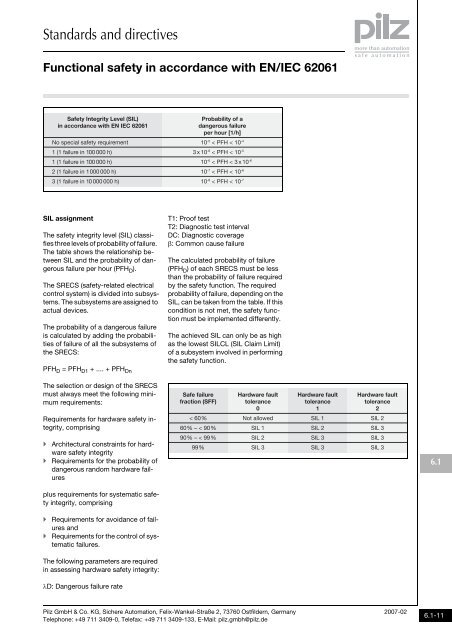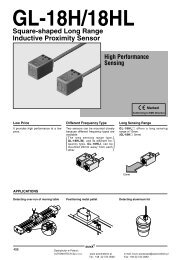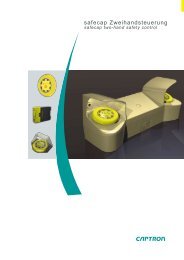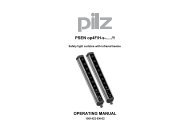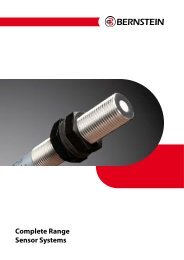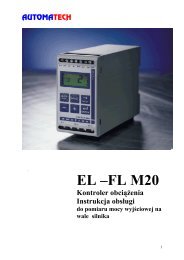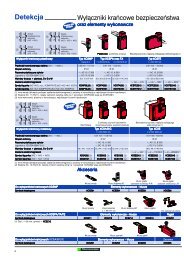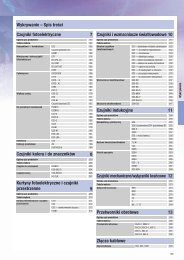Expansion modules - Automatech
Expansion modules - Automatech
Expansion modules - Automatech
You also want an ePaper? Increase the reach of your titles
YUMPU automatically turns print PDFs into web optimized ePapers that Google loves.
Standards and directives<br />
Functional safety in accordance with EN/IEC 62061<br />
207-02Standards andirectivesFunctional safety inacordancewithEN/IEC62061<br />
Safety Integrity Level (SIL)<br />
in accordance with EN IEC 62061<br />
No special safety requirement<br />
1 (1 failure in 100 000 h)<br />
1 (1 failure in 100 000 h)<br />
2 (1 failure in 1000 000 h)<br />
3 (1 failure in 10 000 000 h)<br />
Probability of a<br />
dangerous failure<br />
per hour [1/h]<br />
10 -5 < PFH < 10 -4<br />
3x10 -6 < PFH < 10 -5 111<br />
11110 -6 < PFH < 3 x 10 -6<br />
10 -7 < PFH < 10 -6<br />
10 -8 < PFH < 10 -7<br />
SIL assignment<br />
The safety integrity level (SIL) classifies<br />
three levels of probability of failure.<br />
The table shows the relationship between<br />
SIL and the probability of dangerous<br />
failure per hour (PFH D ).<br />
The SRECS (safety-related electrical<br />
control system) is divided into subsystems.<br />
The subsystems are assigned to<br />
actual devices.<br />
The probability of a dangerous failure<br />
is calculated by adding the probabilities<br />
of failure of all the subsystems of<br />
the SRECS:<br />
PFH D = PFH D1 + .... + PFH Dn<br />
T1: Proof test<br />
T2: Diagnostic test interval<br />
DC: Diagnostic coverage<br />
β: Common cause failure<br />
The calculated probability of failure<br />
(PFH D ) of each SRECS must be less<br />
than the probability of failure required<br />
by the safety function. The required<br />
probability of failure, depending on the<br />
SIL, can be taken from the table. If this<br />
condition is not met, the safety function<br />
must be implemented differently.<br />
The achieved SIL can only be as high<br />
as the lowest SILCL (SIL Claim Limit)<br />
of a subsystem involved in performing<br />
the safety function.<br />
The selection or design of the SRECS<br />
must always meet the following minimum<br />
requirements:<br />
Safe failure<br />
fraction (SFF)<br />
Hardware fault<br />
tolerance<br />
0<br />
Hardware fault<br />
tolerance<br />
1<br />
Hardware fault<br />
tolerance<br />
2<br />
Requirements for hardware safety integrity,<br />
comprising<br />
< 60 %<br />
60 % – < 90 %<br />
Not allowed<br />
SIL 1<br />
SIL 1<br />
SIL 2<br />
SIL 2<br />
SIL 3<br />
Architectural constraints for hardware<br />
safety integrity<br />
Requirements for the probability of<br />
dangerous random hardware failures<br />
90 % – < 99 %<br />
99 %<br />
SIL 2<br />
SIL 3<br />
SIL 3<br />
SIL 3<br />
SIL 3<br />
SIL 3<br />
6.1<br />
plus requirements for systematic safety<br />
integrity, comprising<br />
Requirements for avoidance of failures<br />
and<br />
Requirements for the control of systematic<br />
failures.<br />
The following parameters are required<br />
in assessing hardware safety integrity:<br />
λD: Dangerous failure rate<br />
Pilz GmbH & Co. KG, Sichere Automation, Felix-Wankel-Straße 2, 73760 Ostfildern, Germany<br />
Telephone: +49 711 3409-0, Telefax: +49 711 3409-133, E-Mail: pilz.gmbh@pilz.de<br />
2007-02<br />
6.1-11


